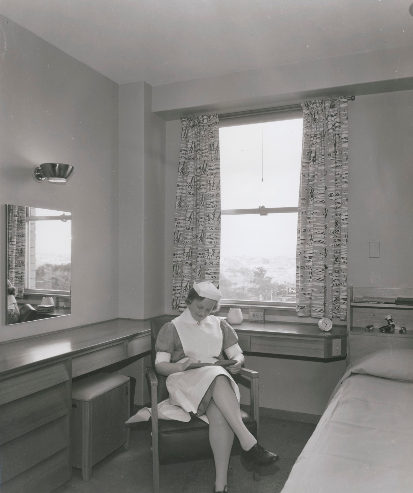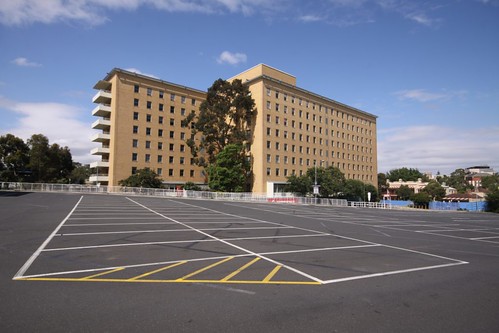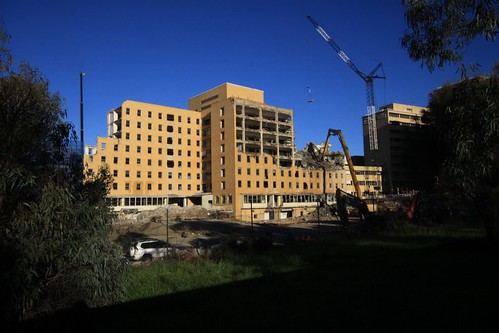The Coronavirus crisis has seen Victoria offer free hotel rooms to health workers so that they can self-isolate, and avoid spreading the virus. But what if I told you that Melbourne hospitals once had their own onsite residential faculties for nursing staff?
Self-isolation of health workers
The desire of Australian health workers to self-isolate emerged early into our response to COVID-19.
Mum is a frontline specialist ED nurse at one of Melbourne’s largest hospitals. She turns 60 next month and spent the day looking for rentals to move into away from dad. To protect him and rest of family while she works.
— David Woiwod (@DavidWoiwod) March 28, 2020
With the Victorian Government response being to pay for hotel rooms.
The Victorian Government has committed $20 million to pay for hotel rooms for healthcare workers who test positive to coronavirus or need to self-isolate while revealing “some wonderful success” in its COVID-19 strategy.
But some people still remember the days that nurses lived at the hospital.
Hospitals have been bulldozing nurses quarters. In the days of hospital-based training you were supplied with seven uniforms which were laundered on site. You were told never to go out in them.
— Sustainable Pain (@PainSustainable) March 28, 2020
Some history
To understand the history of staff living at hospitals, one needs to look at the history of nurse education in Australia – a topic described by Carolyn Keane in her 2016 thesis.
In Australia, the system of training nurses based on the Nightingale system was imported from the UK in the late 1800s to early 1900s. It was a vocational training program that included a theory and clinical component during which trainee nurses would be provided with board and receive the minimum wage. In exchange, the students were expected to provide service to the hospital.
Trainee nurses resided in the nurses’ home during the training period, where they were under the control of the home sister, who herself was a trained nurse. This ‘living-in’ was seen as an essential component of the program.
In this system, the educational needs of the trainee nurse were secondary to the service needs of the hospital. The limited theory given was delivered by doctors, matrons or other healthcare workers in classes that had to fit around the requirements of the hospital. There was no separate budget for the education of nurses, with all hospitals offering nursing training courses at this time.
The scale of nurses’ homes followed that of early hospitals, with the construction of large modern hospitals across Melbourne from the 1940s also seeing a transformation of nurses’ homes.
Each nurse having their own private bedroom.
Alongside shared facilities like tutorial, dining and recreation rooms.
Charles Connibere Building at the Royal Melbourne
The Charles Connibere Memorial Nurses Home was located at the Royal Melbourne Hospital.
The Charles Connibere Memorial Nurses’ Home c1960s. The Royal Woman’s Hospital now stands on the site. #TBT pic.twitter.com/lvgEugaeCr
— The Royal Melbourne Hospital (@TheRMH) June 28, 2017
On the Flemington Road side of the campus.
Funded by the family of the late Sir Charles Connibere – The Argus – 23 October 1941:
£138,860 GIFT TO ROYAL MELBOURNE HOSPITAL
A gift of £ 138 860 made by Messrs Ernest and George Connibere to Royal Melbourne Hospital covers the entire cost of the nurses home now completed at the new hospital buildings, Parkville, which will become a memorial to the donors brother, the late Sir Charles Connibere. The building will be called the Charles Connibere Memorial Nurses’ Home.
The building which is of 11 stories consists of 410 single bedrooms including small suites for the assistant matron and the dietician. Each floor has its own sitting-room with pantry attached. A preliminary training school for student nurses, a suite for the lady superintendent, and main recreation and living quarters for nurses occupy the ground floor. From the lounge glass doors open on to a terrace leading to a private garden.
Residential use of the nurses’ home ended in 1993, with the building then being used as administration offices. The facility was demolished in 2005 to make room for the construction of the new Royal Women’s Hospital, which stands on the site today.
Brookes Gillespie Home for Nurses at the Royal Womens’
The Brookes-Gillespie Home for Nurses was opened by Premier of Victoria, Henry Bolte in 1960, and was located at 740 Swanston Street in Carlton, next door to the former Royal Women’s Hospital.

Museum Victoria photo MM 48635
It eventually acquired by the University of Melbourne, who reopened it in Semester 2, 2003 as an accommodation facility for university students, a role it continues today.
Royal Children’s Hospital nurses home
The Royal Children’s Hospital complex opened at Parkville in 1963 also featured a nurses’ home, on the corner of Flemington Road and Gatehouse Street.
In later years the building was turned over to health researchers, until it was demolished in 2012 as part of the redevelopment of the Royal Children’s Hospital on a new site to the west.
Aikenhead Wing at St Vincent’s
Officially opened in 1960, the 12-storey Aikenhead Wing included 350 bedrooms, training facilities, a chapel, a dining room, shared bathrooms and laundry facilities.

St Vincent’s Hospital Melbourne photo
From the 1990s the building was repurposed for administrative usages, until it was demolished in 2022 to make was for the new Aikenhead Centre for Medical Discovery.
And more examples
St. Andrew’s Hospital in East Melbourne had a attached nurses’ home.
Geelong Hospital had Kitchener House – opened in 1931, but used today by administration staff.
As did the much smaller Swan Hill District Hospital.
And the Austin Hospital in Heidelberg had a few – the heritage listed Marian Drummond Nurses’ Home, Bowen Nurses’ Home and Edward Wilson Nurses’ Home, and the Leslie Jenner Nurses’ Home – completed in 1955 but demolished in 2001 to make way for the Mercy Hospital for Women.
So why did the nurses’ homes close?
Changes in nurse education was the trigger.
By the 1980s, many of the schools of nursing in the smaller, regional and rural hospitals had closed as they did not have the capacity to meet the stringent educational requirements of the state-based nursing registration boards. The 1980s had seen a rapid increase of technology in the health sector and this in turn placed demands on all health professionals to expand their scope of practice with the nursing curriculum increasing from 1,000 to 1,200 hours over the three years training period. When the registration boards proposed an increase to 1,500 hours in order to include the theoretical components necessary for a nurse to be educated to meet the increasing demands of health care, it rendered this type of education no longer viable outside of the larger metropolitan centres.
As universities took over the education task.
Ultimately, it was agreed by the majority of stakeholders that the delivery of a contemporary curriculum reflective of the changes in the health system could only be delivered in the tertiary education sector. The legislation to enable the transfer was passed on 24 August 1984. States and territories moved at various speeds in establishing timetables to implement the transfer. NSW moved quickly and had completed the transfer by 1987 while other jurisdictions embarked on programs to complete the transfer by 1991. Queensland was the last state to enact the reform finally commencing its transfer in 1991 with a three year completion date.
A change that is still questioned today, such as this theses by Lesley Siegloff.
Tension exists today about how nurses are educated in Australia. Many people believe that nurses should be trained in the hospital system while others have argued consistently for pre-registration nursing education to remain in the tertiary education sector. This thesis is focused on understanding how nursing education as we know it today unfolded and was shaped.
Further reading
- Siegloff, Lesley, (2018). Separation, the experience of nursing education and practice in Australia 1964-1994: an autoethnographic study, Flinders University, College of Nursing and Health Sciences
- Keane, C. (2016). An investigation of nurse education service models in acute care metropolitan hospitals across Australia, University of Notre Dame Australia
- Appendix IV: History of Commonwealth involvement in the nursing and midwifery workforce. Department of Health
- Bourke, Anne (2011). Changing purposes and meanings of hospital sites and grounds in Melbourne 1848-1948, University of Melbourne












I believe the former Alfred Hospital Nurses Home is the red brick building on the south-east corner of the Punt Rd and Commercial Rd intersection, in the path of the Punt Rd widening reservation (which seems to both protect it, through making re-use hard, and threatens to destroy it).
An article on the opening of the Nurses Home in 1922:
https://trove.nla.gov.au/newspaper/article/4709591
Thank you for an informative piece of writing about when nurses lived at hospitals. The photographs complemented the writing.
Thanks!